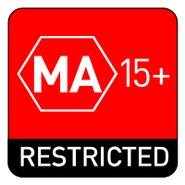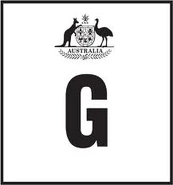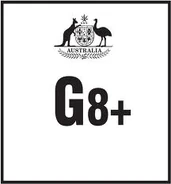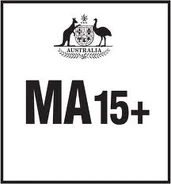The Australian Classification Board and Classification Review Board are government-funded organisations that classify all films and games that are released for public exhibition. The Exempt classification can be used to rate special programs, given that they do not exceed the constraints of the PG classification.
The Australian Classification Board participates in the International Age Rating Coalition in the context of classifying computer games.
Advisory (not restricted by age)[]
Exempt from Classification (E)[]
Exempt from classification. Films that are exempt from classification are usually about general information that is not purposed to entertain. Not shown in the classification database.
General (G) - Suitable for everyone.[]
There are no age restrictions. Children are allowed to view the film. However, a short description of one or more scenes being frightening to young children may be visible. Some G-classified films may contain content that is not of interest to children. The content is very mild in impact. Equivalent to G for movies, EC (which is no longer used) and E for video games and TV-Y, TV-G, TV-Y7-FV and TV-Y7 for television.
Parental Guidance (PG) - Parental guidance is suggested for younger viewers.[]
Parental guidance is recommended. Contains content that is not recommended for children under 15 years without the guidance of their parents or guardians. The content is mild in impact. It is the spiritual successor to the NRC (not recommended for children) rating. Computer games formerly used a similar classification, G8+, which indicates that the computer game is suitable for children aged eight and older. Equivalent to PG for movies[1], E10+ for video games[2] and TV-PG for television.
Mature (M) - Not recommended for children under 15.[]
Recommended for mature audiences. Contains content that is recommended for viewers 15 and over. The content is moderate in impact. Equivalent to PG-13 for movies[3], T for video games[4] and low TV-14 for television.
Restricted[]
Mature Accompanied (MA 15+) - Under 15 requires a guardian.[]
Contains content (sex, violence, or coarse language) in such a manner as to be unsuitable for viewing by people under 15. People under 15 years must be accompanied by a parent or adult guardian. People under 15 years cannot buy MA 15+ classified material unless when accompanied by a parent or adult guardian. In Queensland, unaccompanied children aged under two years can legally see an MA 15+ classified film in a cinema. A person may be asked to show proof of age before hiring or purchasing an MA 15+ classified film. The content is strong in impact. Equivalent to R[5] for movies, M17+[6] for video games and high TV-14 and low TV-MA for television.
Restricted (R 18+) - Restricted to viewers 18 and over.[]
Restricted to 18 years and over (unsuitable for a minor to see). A person may be asked for proof of their age before purchasing, hiring, or viewing an R18+ classified film at a retail store or cinema. Some R 18+ classified films may cause offense to sections of the adult community. The content is high in impact. In Queensland, children under 2 years old can be admitted to R 18+ classified material in cinemas, probably to ensure that the parent or guardian keeps the child safe from being left alone, though the high impact content of R 18+ classified material will surely upset infants. Equivalent to NC-17 for movies[7], AO for video games[8] and high TV-MA for television.
In 2013, R 18+ was introduced for computer games. The first computer game to receive the classification is Ninja Gaiden 3: Razor's Edge. Prior to 2013, R 18+ did not exist for computer games, and high impact content would be "Refused Classification".
Digital content and private viewing is rarely enforced.
Restricted (X 18+) - Adults only; contains sexually explicit content.[]
Restricted to 18 years and over (legally prohibited for those under 18 years of age). Films with this rating have pornographic content, containing only unsimulated sex. However, depictions of sexual violence, coercion and "sexually assaultive" language are not permitted at the X 18+ category. Films classified X 18+ are banned from being sold or rented in all Australian states and are only legally available for sale or hire in Australian Capital Territory and the Northern Territory. However, importing X 18+ classified material from the two territories to any of the Australian states is legal. The content is sexually explicit in impact. It only appears on movies and TV, and not in games. It is against the law to view X 18+ classified content in front of a minor, regardless of private or public viewing. No MPA, ESRB or TV Parental Guidelines equivalent exists.
Other classifications[]
Refused Classification (RC)[]
Banned from sale or hire in Australia; also generally applies to importation (if inspected by and suspicious to Customs). Private Internet viewing is unenforced and attempts to legally censor such online material has resulted in controversy. Content is classified RC if their content exceeds the guidelines (which are very high in impact and exceeds the moral standards of adults). Classification is mandatory, and films that are Refused Classification by the ACB are legally banned for sale, hire or public exhibition. This includes extreme impact violence (including sexual violence), most fetish material, extremely explicit sex scenes, sexual activity involving minors, condoning proscribed or illicit drug use, inciting crime and violence, and detailed instructions of killing or suicide. Examples of films that have been refused classification are Baise-moi (2002) and A Serbian Film (2010).
Anything that:
- 1 (a). depict, express or otherwise deal with matters of sex, drug misuse or addiction, crime, cruelty, violence or revolting or abhorrent phenomena in such a way that they offend against the standards of morality, decency and propriety generally accepted by reasonable adults to the extent that they should not be classified; or
- 1 (b). describe or depict in a way that is likely to cause offense to a reasonable adult, a person who is, or appears to be, a child under 18 (whether the person is engaged in sexual activity or not); or
- 1 (c). promote, incite or instruct in matters of crime or violence
Check the Classification (CTC)[]
Anything that has advertising approval, but has not yet been classified. "This film has advertising approval. Check the classification closer to the released date" is usually written on the marking. Equivalent to "This Film Is Not Yet Rated" for movies and RP for video games.
Rating images[]
Former computer game rating system[]
Until 2005, Australia had a distinct rating system for computer games:
- G: General (suitable for all)
- G8+: Recommended for children aged eight and older.
- M15+: Recommended for those who are at least 15 years old.
- MA15+: Unsuitable for minors under 15 and not to be sold to those under 15 years of age without parental guidance.
Because there was no 18+ rating (unlike the Office of Film and Literature Classification), computer games with high impact content were banned. In 2005, this rating system was absorbed in the Australian Classification Board system, but without the R18+ and the X18+ classifications. G8+ was replaced by PG. High impact content would still be "Refused Classification" prior to the introduction of the R18+ rating for games.
Historical film classifications[]
The first Australian film rating system used in 1938 had three tiers:
- For General Exhibition
- Not Suitable for General Exhibition (1938–1947), Not Suitable for Children (1947–1970)
- Suitable Only for Adults
None of those ratings were legally enforced.
In 1970, a four-tier rating system was introduced when the Australian Classification Board came into existence:
- G: For General Exhibition
- NRC: Not Recommended for Children Under 12
- M: For Mature Audiences
- R: Restricted Exhibition
The R classification was legally enforced, and persons aged under 18 were not admitted.
In 1984, the "X" classification was added to indicate sexually explicit or extremely violent content that would otherwise be refused classification. The sale of sexually explicit material was eventually banned in all of Australia's six states.
In 1993, the MA 15+ classification was added which restricts availability to persons aged 15 and above unless when accompanied by an adult. It is between the M and the R ratings.
Around 2008, content in consumer advice no longer was measured in "levels" (e.g., "low level violence", "medium level coarse language", "high level sex scenes") and instead measured in impact (e.g., "strong drug use", "mild themes", "moderate violence").
The current icons were introduced in 2005, in which "M 15+" was changed to simply "M".
Publication rating system[]
In Australia, publications such as books and magazines (though they would also include other printed media such as calendars, cards and catalogues, among other things) are required to be classified if they contain depictions and/or descriptions of sexuality, drugs, nudity or violence that are unsuitable for a minor or even an adult who would take offence if sold as an unrestricted publication. They are most commonly applied to publications which contain sexualised nudity.
There are four classification categories:
- Unrestricted: These publications are unrestricted, although they may not be recommended for readers under 15 years.
- Category 1 restricted: Publications which generally contain sexualised nudity and are not to be sold to minors. Additionally, they must be distributed in a sealed wrapper, and their covers should be suitable for display in a public place.
- Category 2 restricted: Publications which generally contain actual sexual activity and are not to be sold to minors. Category 2 restricted publications can only be displayed in sites which are restricted to adults.
- RC: Publications which cannot legally be sold or displayed anywhere in Australia.
In addition, restricted publications are not to be sold in Queensland according to state law.
Advertising[]
Unclassified film or computer game[]
If a film or computer game has been assessed and given a likely classification by the Board, the distributor can advertise it; however, advertising unclassified content may result in legal action depending on the content's subsequent rating.
Advertising unclassified works with other classified works[]
Unclassified works can only be advertised with a classified work when it has been assessed as likely to be the same classification or lower.
- Likely G: can be advertised in any classification
- Likely PG: can be advertised in any classification except G
- Likely M: can be advertised in any classification except G or PG
- Likely MA 15+: can be advertised in either restricted classification
- Likely R 18+: can be advertised in R 18+ only
Check the Classification[]
Advertising unclassified works must include a message of either CTC or Check the Classification.
Classified film or computer game[]
Works with a classification of G, PG, M, MA 15+, or R 18+ can be advertised. Works that have been classified RC cannot be legally advertised within Australia.
Importing or exporting objectionable goods[]
According to the Board, importing or exporting objectionable goods requires permission to do so, as it is usually prohibited to import or export items that are classified RC.
Videos[]
Trivia[]
- The M rating allows use of the word "f**k" multiple times, unlike other unrestricted ratings in other English-speaking countries.
- There has been confusion between the PG, M and MA15+ ratings due to the fact each one is associated with the age 15, with PG stating parental guidance recommended for viewers under 15 years, M stating not recommended for viewers under 15 years, and MA15+ stating restricted to 15 years and over.
- The G rating, unlike other general ratings, can have consumer advice.
- PG rated movies may contain a use of the F word if justified by context.
- This goes for M too, except with the C word.
Notes[]
- ↑ ...However, there are some PG-13 rated movies that only got a PG in Australia.
- ↑ ...However, there are some T rated video games that only got a PG in Australia.
- ↑ ...However, there are some R-rated movies that only got an M in Australia.
- ↑ ...However, there are some M17+ rated video games that only got an M in Australia.
- ↑ ...However, there have been some PG-13 rated movies that were rated MA15+ in Australia.
- ↑ ...However, there have been many M17+ rated games that were classified R18+ in Australia.
- ↑ ...However, lots of R-rated movies have received an R 18+ rating in Australia (prior to the creation of the MA 15+ classification).
- ↑ ...However, there are some M17+ rated video games that got an R 18+ in Australia.
| Australian Classification Board (ACB) |
|---|
      
|
















